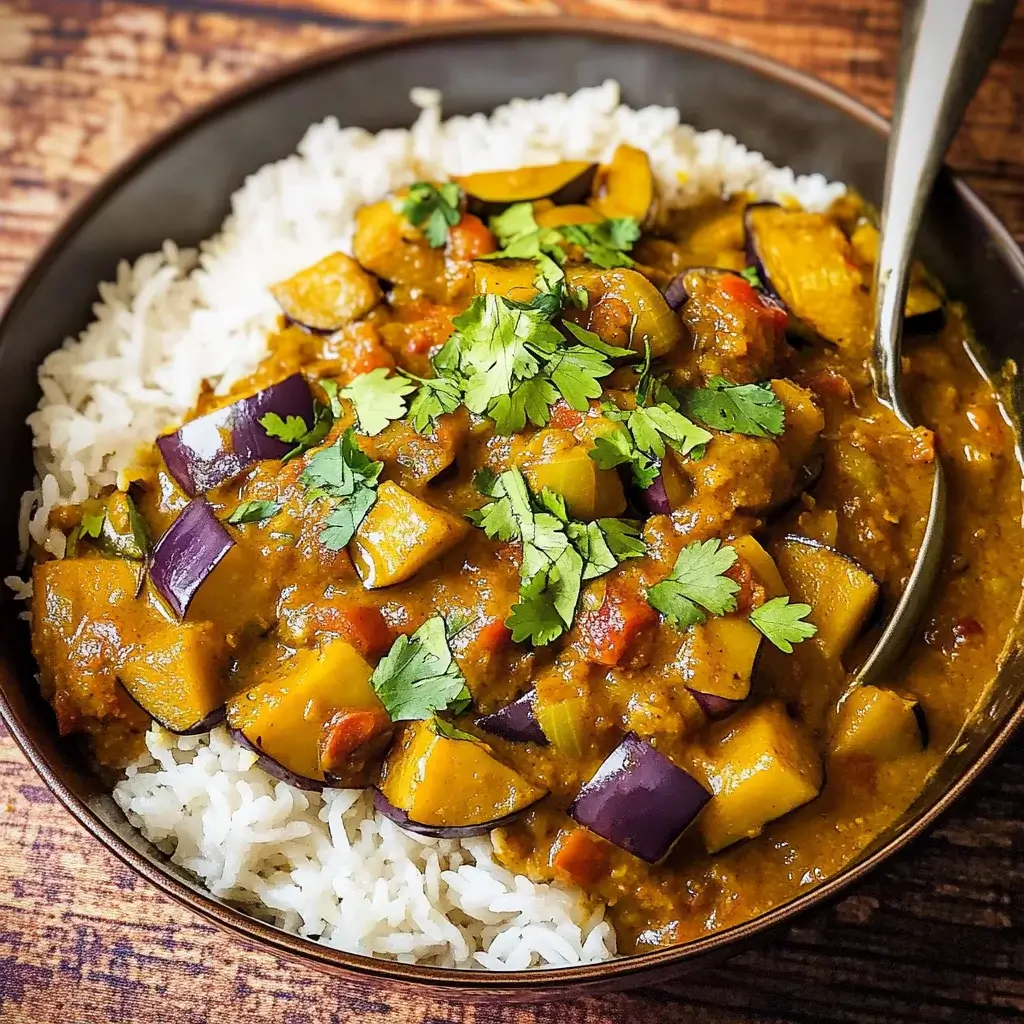Weeknights in our house can often feel like a race against the clock. Between work, school runs, and after-school activities, finding time to cook a healthy and delicious dinner sometimes feels like a Herculean task. Takeout menus often beckon, but I always crave something homemade, something vibrant and flavorful that nourishes both body and soul. That’s when this Spicy Eggplant Curry recipe became my absolute savior. It’s unbelievably quick to throw together, bursting with bold, spicy flavors, and packed with wholesome ingredients. The first time I made it, I was amazed at how easily it all came together. The aroma of spices filling the kitchen was instantly comforting, and the first bite was a revelation – tender, melt-in-your-mouth eggplant coated in a rich, fiery, and utterly addictive curry sauce. Even my spice-averse partner, initially hesitant about the “spicy” label, was completely won over, declaring it a new weeknight favorite. This isn’t just an easy dinner; it’s an explosion of flavor that transforms an ordinary evening into a culinary adventure. Get ready to ditch the takeout and embrace the delicious simplicity of this spicy eggplant curry!
Ingredients
This Spicy Eggplant Curry relies on a harmonious blend of fresh and pantry-staple ingredients to create its vibrant and deeply satisfying flavor profile. Here’s what you’ll need to gather to bring this culinary magic to your kitchen:
For the Curry Base:
- 1 large onion, finely chopped: Onion forms the aromatic foundation of the curry, providing sweetness and depth. Yellow or white onions work equally well.
- 2-3 cloves garlic, minced: Garlic adds pungent, savory notes that are essential to the curry’s complexity. Freshly minced garlic is always preferred, but you can use garlic paste in a pinch.
- 1-inch ginger, grated or finely minced: Fresh ginger brings a warm, zesty, and slightly spicy kick, contributing to the curry’s overall vibrancy. You can use ginger paste if fresh ginger is unavailable.
- 1-2 green chilies, finely chopped (adjust to your spice preference): Green chilies are the primary source of heat in this curry. Serrano chilies or Thai green chilies work well. For a milder curry, remove the seeds and membranes, or use a milder chili like jalapeño and use only half. For extra heat, you can use hotter varieties like bird’s eye chilies, but use them sparingly.
- 2 tablespoons vegetable oil (or coconut oil): Oil is used to sauté the aromatics and cook the curry base. Vegetable oil is neutral in flavor, while coconut oil adds a subtle sweetness and enhances the curry’s richness, especially if aiming for a more South Indian or Thai-inspired flavor profile.
- 1 teaspoon cumin seeds: Cumin seeds, when toasted in oil, release a warm, earthy aroma that is foundational to many curries.
- 1 teaspoon mustard seeds (black or brown): Mustard seeds add a slightly nutty and pungent flavor that pops and crackles in hot oil, releasing their aroma and contributing a unique textural element. Black mustard seeds are more pungent than brown mustard seeds.
- 1 teaspoon turmeric powder: Turmeric powder imparts a warm, earthy flavor and a vibrant golden color to the curry. It also has numerous health benefits, known for its anti-inflammatory properties.
- 1 teaspoon coriander powder: Coriander powder adds a warm, citrusy, and slightly sweet flavor that balances the earthiness of cumin and turmeric.
- 1/2 teaspoon chili powder (adjust to your spice preference): Chili powder adds an extra layer of heat and depth of flavor. Use a good quality chili powder for the best taste. You can use Kashmiri chili powder for a vibrant red color and milder heat, or cayenne pepper for a stronger kick.
- 1/2 teaspoon garam masala: Garam masala is a blend of warm spices that is added towards the end of cooking to enhance the overall aroma and flavor of the curry. Use a good quality garam masala for the best results. You can also make your own garam masala blend for a truly authentic flavor.
- 1 (14.5 oz) can diced tomatoes, undrained: Diced tomatoes form the base of the curry sauce, providing acidity, sweetness, and moisture. Use good quality diced tomatoes for the best flavor. You can also use fresh tomatoes, roughly chopped, but you may need to cook them down longer to reduce their liquid content and intensify their flavor.
- 1/2 cup vegetable broth (or water): Vegetable broth adds depth of flavor to the curry sauce. Water can be used as a substitute if broth is not available, but broth is recommended for a richer taste.
For the Eggplant:
- 2 medium eggplants (about 1 pound total), cut into 1-inch cubes: Eggplant is the star of the dish, providing a creamy, melt-in-your-mouth texture when cooked in the curry. Globe eggplant or Italian eggplant work well. Smaller varieties like Japanese or Chinese eggplant can also be used; adjust the cooking time accordingly.
- Salt, for drawing out moisture from eggplant: Salt is used to draw out excess moisture from the eggplant, which helps prevent it from becoming soggy and allows it to absorb the flavors of the curry better.
For Finishing and Garnishing:
- 1/4 cup chopped fresh cilantro, for garnish: Fresh cilantro adds a bright, herbaceous, and refreshing finish to the curry.
- Lemon or lime wedges, for serving (optional): A squeeze of lemon or lime juice adds a touch of acidity that brightens the flavors of the curry and complements the spices.
Detailed Ingredient Notes and Substitutions:
- Spice Level Adjustment: The spice level of this curry is easily adjustable. Reduce or omit the green chilies and chili powder for a milder version. Add more green chilies, chili powder, or a pinch of cayenne pepper for extra heat. You can also use a hot sauce like sriracha or chili garlic sauce to customize the spice level.
- Eggplant Variety: Globe eggplant is the most common type and works perfectly in this recipe. Italian eggplant is similar and also a good choice. Japanese or Chinese eggplant are more slender and have thinner skin, they cook faster and can be used, but may become softer quicker.
- Oil Choice: Vegetable oil is a neutral option. Coconut oil adds a subtle sweetness and aroma, especially suitable for South Indian or Thai-inspired curries. Ghee (clarified butter) can also be used for a richer flavor, if you are not aiming for a vegan dish.
- Tomato Variations: Diced tomatoes are convenient, but you can also use crushed tomatoes or tomato puree for a smoother sauce. Fresh tomatoes, about 4-5 medium, can be used instead of canned, but you’ll need to cook them down longer to reduce liquid and intensify flavor.
- Vegan Option: This recipe is naturally vegan. Ensure you are using vegetable oil or coconut oil and vegetable broth to maintain its vegan status.
- Gluten-Free Option: This recipe is naturally gluten-free.
- Onion and Garlic Alternatives: Shallots can be used instead of onions for a milder, sweeter flavor. Garlic paste or pre-minced garlic can be used if fresh garlic is not available.
- Ginger Alternatives: Ginger paste or dried ginger powder can be used, but fresh ginger provides the most vibrant flavor.
- Fresh Cilantro Substitute: Fresh parsley or mint can be used as a garnish if cilantro is not preferred.
Instructions
Making this Spicy Eggplant Curry is surprisingly simple and quick, perfect for a satisfying weeknight dinner. Follow these easy steps to create a flavorful and aromatic curry:
Step 1: Prepare the Eggplant
- Wash the eggplants and cut them into 1-inch cubes.
- Place the cubed eggplant in a colander and sprinkle generously with salt. Toss to coat evenly.
- Let the eggplant sit for 20-30 minutes. This process, called “drawing out moisture,” helps to remove excess water from the eggplant, preventing it from becoming soggy during cooking and improving its texture and ability to absorb flavors.
- After 20-30 minutes, rinse the eggplant thoroughly under cold running water to remove the salt. Gently squeeze out any excess water. Pat the eggplant cubes dry with paper towels.
Step 2: Temper the Spices and Sauté Aromatics
- Heat vegetable oil (or coconut oil) in a large pot or Dutch oven over medium heat.
- Once the oil is hot, add cumin seeds and mustard seeds. Let them splutter and crackle for about 30 seconds to a minute. This process, called “tempering,” releases the aromatic oils from the spices and enhances their flavor. Be careful not to burn the spices.
- Add finely chopped onion and sauté until golden brown, about 5-7 minutes. Stir occasionally to prevent sticking.
- Add minced garlic, grated ginger, and chopped green chilies to the pot. Sauté for another minute until fragrant, stirring constantly to prevent garlic from burning.
Step 3: Add Spice Powders and Tomatoes
- Reduce heat to low. Add turmeric powder, coriander powder, and chili powder to the pot. Sauté for about 30 seconds, stirring constantly, until fragrant. Be careful not to burn the spice powders; if they start to stick, add a splash of vegetable broth or water. Sautéing the spice powders in oil enhances their flavor and aroma.
- Add the can of diced tomatoes (undrained) to the pot. Stir well to combine with the spices and aromatics.
- Increase heat to medium and bring the mixture to a simmer. Cook for 5-7 minutes, stirring occasionally, until the tomatoes have broken down and the sauce has slightly thickened.
Step 4: Add Eggplant and Simmer
- Add the prepared eggplant cubes to the pot. Stir to coat them evenly with the curry sauce.
- Pour in vegetable broth (or water). Stir well to combine.
- Bring the curry to a simmer, then reduce heat to low, cover the pot, and simmer for 15-20 minutes, or until the eggplant is tender and cooked through. Stir occasionally to prevent sticking and ensure even cooking. The eggplant should be easily pierced with a fork when done.
Step 5: Finish and Garnish
- Once the eggplant is tender, stir in garam masala. Cook for another minute to allow the garam masala to infuse its aroma and flavor into the curry.
- Taste and adjust seasoning if needed. Add more salt, chili powder, or garam masala to your liking.
- Remove from heat and stir in fresh cilantro.
- Serve hot, garnished with extra cilantro and lemon or lime wedges (optional).
Detailed Instruction Notes and Tips:
- Eggplant Salting: Don’t skip the eggplant salting step. It significantly improves the texture of the eggplant in the curry.
- Spice Tempering: Tempering the cumin and mustard seeds in hot oil is crucial for unlocking their full flavor potential. Watch them closely to prevent burning.
- Sautéing Aromatics: Sautéing the onion, garlic, and ginger until golden brown is essential for building a flavorful curry base. Don’t rush this step.
- Spice Powder Sautéing: Sautéing the spice powders briefly in oil enhances their aroma and flavor. Be careful not to burn them, which can make the curry taste bitter.
- Simmering Time: The simmering time may vary depending on the size of your eggplant cubes and your desired level of tenderness. Check the eggplant for doneness after 15 minutes and continue simmering if needed.
- Water/Broth Adjustment: If the curry sauce becomes too thick during simmering, add a little more vegetable broth or water to reach your desired consistency. If it’s too thin, simmer uncovered for a few minutes to reduce the liquid.
- Spice Customization: Feel free to adjust the amount of green chilies and chili powder to customize the spice level to your preference. You can also add other spices like fenugreek leaves (kasuri methi) for a more complex flavor.
- Garnish Options: Besides cilantro, you can also garnish with a dollop of plain yogurt (if not vegan), a swirl of coconut cream (for a richer vegan option), or chopped green onions.
Nutrition Facts
(Estimated per serving, assuming 4 servings per recipe. Nutritional values are approximate and can vary based on specific ingredients and portion sizes.)
- Serving Size: Approximately 1.5 cups of curry
- Calories: Approximately 250-350 calories per serving
- Protein: 5-7 grams
- Fat: 15-20 grams
- Saturated Fat: 2-4 grams (depending on oil used)
- Cholesterol: 0 mg
- Sodium: 500-700 mg (depending on salt added and broth used)
- Carbohydrates: 25-35 grams
- Fiber: 8-10 grams
- Sugar: 8-12 grams (naturally occurring from tomatoes and vegetables)
Important Note: These nutritional facts are estimates and can vary significantly based on the specific brands and types of ingredients used, portion sizes, and cooking methods. For more accurate nutritional information, it is recommended to use a nutrition calculator and input the specific ingredients and quantities you use in your recipe. This curry is naturally rich in fiber, vitamins, and minerals from the eggplant, tomatoes, and spices. It can be a healthy and satisfying meal option, especially when served with whole grains like brown rice or quinoa.
Preparation Time
This Easy-Dinner Spicy Eggplant Curry lives up to its name, requiring minimal preparation and cooking time, making it perfect for busy weeknights.
- Prep Time: 20 minutes (includes chopping vegetables and salting eggplant)
- Cook Time: 30 minutes
- Total Time: 50 minutes
Time-Saving Tips:
- Pre-chop Vegetables: Chop the onion, garlic, ginger, and green chilies in advance and store them in airtight containers in the refrigerator for up to a day.
- Use Pre-minced Garlic and Ginger Paste: If you’re really short on time, you can use pre-minced garlic and ginger paste to save a few minutes of prep work.
- Meal Prep Component: You can prepare the curry base (up to step 3) a day or two in advance and store it in the refrigerator. When ready to cook, simply reheat the base and proceed from step 4 by adding the eggplant.
How to Serve
This Spicy Eggplant Curry is incredibly versatile and can be served in a variety of ways to create a complete and satisfying meal. Here are some serving suggestions:
- With Rice:
- Basmati Rice: Classic and fragrant, basmati rice is a perfect accompaniment to eggplant curry. Its light and fluffy texture complements the rich curry sauce.
- Brown Rice: For a healthier option, serve with brown rice. Its nutty flavor and chewy texture add another dimension to the meal.
- Jasmine Rice: Another fragrant white rice variety that pairs well with curries.
- Quinoa: A protein-rich and gluten-free alternative to rice.
- With Indian Breads:
- Naan: Soft and pillowy naan bread is perfect for scooping up the delicious curry sauce.
- Roti or Chapati: Whole wheat flatbreads that are a staple in Indian cuisine.
- Paratha: Flaky and layered flatbread, a richer option compared to roti.
- As Part of a Thali:
- Create a traditional Indian thali (platter) by serving the eggplant curry alongside other vegetarian dishes like:
- Dal (Lentil Soup): A comforting and protein-rich lentil dish.
- Vegetable Stir-fry (Bhaji): A dry vegetable side dish.
- Raita (Yogurt Dip): A cooling yogurt dip with vegetables or spices.
- Pickles and Papadum: For extra flavor and texture.
- Create a traditional Indian thali (platter) by serving the eggplant curry alongside other vegetarian dishes like:
- Garnishes to Enhance the Serving:
- Fresh Cilantro: A must-have garnish for its fresh and herbaceous flavor.
- Lemon or Lime Wedges: For a squeeze of acidity to brighten the flavors.
- Plain Yogurt or Coconut Cream: A cooling and creamy topping, especially if the curry is spicy.
- Chopped Green Onions: For a mild oniony flavor and visual appeal.
- Toasted Sesame Seeds: Add a nutty flavor and textural crunch.
- A drizzle of chili oil: For extra heat and visual appeal.
- Serving Style Ideas:
- Family Style: Serve the eggplant curry in a large serving bowl in the center of the table, allowing everyone to help themselves.
- Individual Bowls: Portion the curry into individual bowls and garnish each serving attractively.
- Plated with Rice: Spoon rice onto plates and top with a generous serving of eggplant curry.
Additional Tips for Delicious Spicy Eggplant Curry
Here are five extra tips to elevate your Spicy Eggplant Curry and ensure it’s a resounding success every time:
- Roast or Grill the Eggplant for Deeper Flavor: For an even richer and smokier flavor, consider roasting or grilling the eggplant cubes before adding them to the curry. Toss the eggplant with a little olive oil, salt, and pepper, and roast at 400°F (200°C) for about 20-25 minutes until tender and slightly caramelized, or grill until slightly charred and tender. This pre-cooking method intensifies the eggplant’s flavor and texture.
- Bloom Your Spices in Oil Properly: Don’t rush the spice tempering and sautéing process. Allowing the cumin and mustard seeds to splutter and crackle in hot oil, and sautéing the spice powders briefly, is crucial for releasing their full flavor potential. This “blooming” technique is a key element in creating a flavorful curry.
- Adjust Spice Level to Your Preference: Start with the recommended amount of green chilies and chili powder, and then taste and adjust as needed. Remember you can always add more spice, but it’s harder to take it away. If you are unsure about your spice tolerance, start with less and add more gradually. You can also serve a side of yogurt or raita to cool down the palate if the curry is too spicy.
- Simmer for Flavor Development: Don’t rush the simmering process. Simmering the curry for at least 15-20 minutes allows the flavors to meld together and deepen, creating a more complex and satisfying curry. The longer it simmers (within reason, without drying out), the more flavorful it will become.
- Fresh is Best, When Possible: While dried spices are essential, using fresh aromatics like onion, garlic, ginger, and green chilies makes a significant difference in the overall flavor of the curry. Whenever possible, opt for fresh ingredients for the most vibrant and aromatic curry. Fresh cilantro garnish is also crucial for adding a final layer of freshness and brightness.
Frequently Asked Questions (FAQ)
Here are some common questions you might have about making Easy-Dinner Spicy Eggplant Curry:
Q1: Can I make this curry ahead of time?
A: Absolutely! In fact, eggplant curry often tastes even better the next day as the flavors have had more time to meld and deepen. You can prepare the entire curry or just the curry base (up to step 3) ahead of time. Store it in an airtight container in the refrigerator for up to 3-4 days. Reheat gently on the stovetop or in the microwave before serving.
Q2: Can I freeze eggplant curry?
A: Yes, you can freeze eggplant curry. Allow it to cool completely before transferring it to freezer-safe containers or zip-top bags. Freeze for up to 2-3 months. Thaw overnight in the refrigerator before reheating. The texture of the eggplant might be slightly softer after freezing and thawing, but the flavor will still be delicious.
Q3: I don’t like eggplant. Can I substitute it with another vegetable?
A: While eggplant is the star of this recipe, you can substitute it with other vegetables if you are not a fan. Good alternatives include:
* Potatoes: Use diced potatoes (about 1-inch cubes) and adjust the cooking time accordingly, as potatoes may take slightly longer to cook than eggplant.
* Cauliflower: Use cauliflower florets. They will cook similarly to eggplant.
* Chickpeas: Add cooked chickpeas for a protein-rich curry. Add them towards the end of cooking as they are already cooked.
* Mixed Vegetables: A combination of vegetables like bell peppers, zucchini, and green beans can also be used.
Q4: How can I make this curry less spicy?
A: To reduce the spice level:
* Reduce or omit green chilies: Green chilies are a primary source of heat. Reduce the number of green chilies or omit them altogether.
* Remove seeds and membranes from chilies: If using green chilies, remove the seeds and membranes, which contain most of the heat.
* Reduce chili powder: Use less chili powder or use a milder chili powder like Kashmiri chili powder.
* Add yogurt or coconut cream: Serving the curry with a dollop of plain yogurt or coconut cream can help cool down the spice.
Q5: Is this eggplant curry vegan and gluten-free?
A: Yes, this Easy-Dinner Spicy Eggplant Curry is naturally vegan and gluten-free. Ensure you are using vegetable oil or coconut oil and vegetable broth to maintain its vegan status. All the spices and other ingredients listed are naturally gluten-free. Serve it with rice or gluten-free bread options to keep the entire meal gluten-free.
Print
Easy-Dinner Spicy Eggplant Curry recipe
Ingredients
- 1 large onion, finely chopped: Onion forms the aromatic foundation of the curry, providing sweetness and depth. Yellow or white onions work equally well.
- 2–3 cloves garlic, minced: Garlic adds pungent, savory notes that are essential to the curry’s complexity. Freshly minced garlic is always preferred, but you can use garlic paste in a pinch.
- 1-inch ginger, grated or finely minced: Fresh ginger brings a warm, zesty, and slightly spicy kick, contributing to the curry’s overall vibrancy. You can use ginger paste if fresh ginger is unavailable.
- 1–2 green chilies, finely chopped (adjust to your spice preference): Green chilies are the primary source of heat in this curry. Serrano chilies or Thai green chilies work well. For a milder curry, remove the seeds and membranes, or use a milder chili like jalapeño and use only half. For extra heat, you can use hotter varieties like bird’s eye chilies, but use them sparingly.
- 2 tablespoons vegetable oil (or coconut oil): Oil is used to sauté the aromatics and cook the curry base. Vegetable oil is neutral in flavor, while coconut oil adds a subtle sweetness and enhances the curry’s richness, especially if aiming for a more South Indian or Thai-inspired flavor profile.
- 1 teaspoon cumin seeds: Cumin seeds, when toasted in oil, release a warm, earthy aroma that is foundational to many curries.
- 1 teaspoon mustard seeds (black or brown): Mustard seeds add a slightly nutty and pungent flavor that pops and crackles in hot oil, releasing their aroma and contributing a unique textural element. Black mustard seeds are more pungent than brown mustard seeds.
- 1 teaspoon turmeric powder: Turmeric powder imparts a warm, earthy flavor and a vibrant golden color to the curry. It also has numerous health benefits, known for its anti-inflammatory properties.
- 1 teaspoon coriander powder: Coriander powder adds a warm, citrusy, and slightly sweet flavor that balances the earthiness of cumin and turmeric.
- 1/2 teaspoon chili powder (adjust to your spice preference): Chili powder adds an extra layer of heat and depth of flavor. Use a good quality chili powder for the best taste. You can use Kashmiri chili powder for a vibrant red color and milder heat, or cayenne pepper for a stronger kick.
- 1/2 teaspoon garam masala: Garam masala is a blend of warm spices that is added towards the end of cooking to enhance the overall aroma and flavor of the curry. Use a good quality garam masala for the best results. You can also make your own garam masala blend for a truly authentic flavor.
- 1 (14.5 oz) can diced tomatoes, undrained: Diced tomatoes form the base of the curry sauce, providing acidity, sweetness, and moisture. Use good quality diced tomatoes for the best flavor. You can also use fresh tomatoes, roughly chopped, but you may need to cook them down longer to reduce their liquid content and intensify their flavor.
- 1/2 cup vegetable broth (or water): Vegetable broth adds depth of flavor to the curry sauce. Water can be used as a substitute if broth is not available, but broth is recommended for a richer taste.
For the Eggplant:
- 2 medium eggplants (about 1 pound total), cut into 1-inch cubes: Eggplant is the star of the dish, providing a creamy, melt-in-your-mouth texture when cooked in the curry. Globe eggplant or Italian eggplant work well. Smaller varieties like Japanese or Chinese eggplant can also be used; adjust the cooking time accordingly.
- Salt, for drawing out moisture from eggplant: Salt is used to draw out excess moisture from the eggplant, which helps prevent it from becoming soggy and allows it to absorb the flavors of the curry better.
For Finishing and Garnishing:
- 1/4 cup chopped fresh cilantro, for garnish: Fresh cilantro adds a bright, herbaceous, and refreshing finish to the curry.
- Lemon or lime wedges, for serving (optional): A squeeze of lemon or lime juice adds a touch of acidity that brightens the flavors of the curry and complements the spices.
Detailed Ingredient Notes and Substitutions:
- Spice Level Adjustment: The spice level of this curry is easily adjustable. Reduce or omit the green chilies and chili powder for a milder version. Add more green chilies, chili powder, or a pinch of cayenne pepper for extra heat. You can also use a hot sauce like sriracha or chili garlic sauce to customize the spice level.
- Eggplant Variety: Globe eggplant is the most common type and works perfectly in this recipe. Italian eggplant is similar and also a good choice. Japanese or Chinese eggplant are more slender and have thinner skin, they cook faster and can be used, but may become softer quicker.
- Oil Choice: Vegetable oil is a neutral option. Coconut oil adds a subtle sweetness and aroma, especially suitable for South Indian or Thai-inspired curries. Ghee (clarified butter) can also be used for a richer flavor, if you are not aiming for a vegan dish.
- Tomato Variations: Diced tomatoes are convenient, but you can also use crushed tomatoes or tomato puree for a smoother sauce. Fresh tomatoes, about 4-5 medium, can be used instead of canned, but you’ll need to cook them down longer to reduce liquid and intensify flavor.
- Vegan Option: This recipe is naturally vegan. Ensure you are using vegetable oil or coconut oil and vegetable broth to maintain its vegan status.
- Gluten-Free Option: This recipe is naturally gluten-free.
- Onion and Garlic Alternatives: Shallots can be used instead of onions for a milder, sweeter flavor. Garlic paste or pre-minced garlic can be used if fresh garlic is not available.
- Ginger Alternatives: Ginger paste or dried ginger powder can be used, but fresh ginger provides the most vibrant flavor.
- Fresh Cilantro Substitute: Fresh parsley or mint can be used as a garnish if cilantro is not preferred.
Instructions
Step 1: Prepare the Eggplant
- Wash the eggplants and cut them into 1-inch cubes.
- Place the cubed eggplant in a colander and sprinkle generously with salt. Toss to coat evenly.
- Let the eggplant sit for 20-30 minutes. This process, called “drawing out moisture,” helps to remove excess water from the eggplant, preventing it from becoming soggy during cooking and improving its texture and ability to absorb flavors.
- After 20-30 minutes, rinse the eggplant thoroughly under cold running water to remove the salt. Gently squeeze out any excess water. Pat the eggplant cubes dry with paper towels.
Step 2: Temper the Spices and Sauté Aromatics
- Heat vegetable oil (or coconut oil) in a large pot or Dutch oven over medium heat.
- Once the oil is hot, add cumin seeds and mustard seeds. Let them splutter and crackle for about 30 seconds to a minute. This process, called “tempering,” releases the aromatic oils from the spices and enhances their flavor. Be careful not to burn the spices.
- Add finely chopped onion and sauté until golden brown, about 5-7 minutes. Stir occasionally to prevent sticking.
- Add minced garlic, grated ginger, and chopped green chilies to the pot. Sauté for another minute until fragrant, stirring constantly to prevent garlic from burning.
Step 3: Add Spice Powders and Tomatoes
- Reduce heat to low. Add turmeric powder, coriander powder, and chili powder to the pot. Sauté for about 30 seconds, stirring constantly, until fragrant. Be careful not to burn the spice powders; if they start to stick, add a splash of vegetable broth or water. Sautéing the spice powders in oil enhances their flavor and aroma.
- Add the can of diced tomatoes (undrained) to the pot. Stir well to combine with the spices and aromatics.
- Increase heat to medium and bring the mixture to a simmer. Cook for 5-7 minutes, stirring occasionally, until the tomatoes have broken down and the sauce has slightly thickened.
Step 4: Add Eggplant and Simmer
- Add the prepared eggplant cubes to the pot. Stir to coat them evenly with the curry sauce.
- Pour in vegetable broth (or water). Stir well to combine.
- Bring the curry to a simmer, then reduce heat to low, cover the pot, and simmer for 15-20 minutes, or until the eggplant is tender and cooked through. Stir occasionally to prevent sticking and ensure even cooking. The eggplant should be easily pierced with a fork when done.
Step 5: Finish and Garnish
- Once the eggplant is tender, stir in garam masala. Cook for another minute to allow the garam masala to infuse its aroma and flavor into the curry.
- Taste and adjust seasoning if needed. Add more salt, chili powder, or garam masala to your liking.
- Remove from heat and stir in fresh cilantro.
- Serve hot, garnished with extra cilantro and lemon or lime wedges (optional).
Detailed Instruction Notes and Tips:
- Eggplant Salting: Don’t skip the eggplant salting step. It significantly improves the texture of the eggplant in the curry.
- Spice Tempering: Tempering the cumin and mustard seeds in hot oil is crucial for unlocking their full flavor potential. Watch them closely to prevent burning.
- Sautéing Aromatics: Sautéing the onion, garlic, and ginger until golden brown is essential for building a flavorful curry base. Don’t rush this step.
- Spice Powder Sautéing: Sautéing the spice powders briefly in oil enhances their aroma and flavor. Be careful not to burn them, which can make the curry taste bitter.
- Simmering Time: The simmering time may vary depending on the size of your eggplant cubes and your desired level of tenderness. Check the eggplant for doneness after 15 minutes and continue simmering if needed.
- Water/Broth Adjustment: If the curry sauce becomes too thick during simmering, add a little more vegetable broth or water to reach your desired consistency. If it’s too thin, simmer uncovered for a few minutes to reduce the liquid.
- Spice Customization: Feel free to adjust the amount of green chilies and chili powder to customize the spice level to your preference. You can also add other spices like fenugreek leaves (kasuri methi) for a more complex flavor.
- Garnish Options: Besides cilantro, you can also garnish with a dollop of plain yogurt (if not vegan), a swirl of coconut cream (for a richer vegan option), or chopped green onions.
Nutrition
- Serving Size: one normal portion
- Calories: 250-350 calories
- Sugar: 8-12 grams
- Sodium: 500-700 mg
- Fat: 15-20 grams
- Saturated Fat: 2-4 grams
- Carbohydrates: 25-35 grams
- Fiber: 8-10 grams
- Protein: 5-7 grams
- Cholesterol: 0 mg






